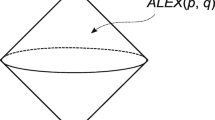Abstract
I reconstruct from Rietdijk and Putnam’s well-known papers an argument against the applicability of the concept of becoming in Special Relativity, which I think is unaffected by some of the objections found in the literature. I then consider a line of thought found in the discussion of the possible conventionality of simultaneity in Special Relativity, beginning with Reichenbach, and apply it to the debate over becoming. We see that it immediately renders Rietdijk and Putnam’s argument unsound. I end by comparing my approach to others found in the literature, primarily Stein’s.
Similar content being viewed by others
Notes
Godfrey-Smith later changed his name to Grey; I shall refer to him below by his present name.
I don’t know who first drew this distinction in the literature, but it is found already in (Sklar 1974, p. 273).
Like Stein, Clifton and Hogarth stipulate a time orientation and work with a ‘beefed-up structure of time-oriented Minkowski spacetime’. What justifies taking ‘time-orientation […] to be an objective property of the world’ they deem a difficult issue, which they don’t try to resolve (1995, p. 359). In this way much of the work of refuting Rietdijk and Putnam’s argument is done by an unjustified stipulation. Referring to Reichenbachian causal considerations, by contrast, justifies an additional directional element and also immediately yields the desired result. When Clifton and Hogarth discuss causality’s relation to becoming, they consider impossible travels in the speed of light; subjects’ alleged psychological sense of becoming, including that of such subjects who, per impossiblile, move in the speed of light; and the suggestion to take all points on a backward light cone of an event as sharing the same ‘now’ with it (364–365). Their approach to the relation of causality to temporal concepts is thus quite unlike the one considered in this paper.
References
Ben-Yami H (2006) Causality and temporal order in special relativity. Br J Philos Sci 57:459–479
Clifton R, Hogarth M (1995) The definability of objective becoming in Minkowski spacetime. Synthese 103:355–387
Einstein A (1905) Zur Elektrodynamik bewegter Körper. Ann Phys 17:891–921
Einstein A (1920) Relativity: the special and the general theory. (trans: Lawson RW). Republished by Penguin Books, 2006
Einstein A (1949) Autobiographical notes. In: Schilpp P (ed) Albert Einstein: philosopher–scientist. Open Court, La Salle, Il
Godfrey-Smith W (1979) Special relativity and the present. Philos Stud 36:233–244
Hinchliff M (2000) A defense of presentism in a relativistic setting. Philos Sci 67:S575–S586
Malament D (1977) Causal theories of time and the conventionality of simultaneity. Noûs 11:293–300
Maxwell N (1985) Are probabilism and special relativity incompatible? Philos Sci 52:23–43
Putnam H (1967) Time and physical geometry. J Philos 64:240–247
Reichenbach H (1928) Philosophie der Raum-Zeit-Lehre. The philosophy of space & time (trans: Reichenbach M, Freund J). Dover, New York, 1958
Rietdijk CW (1966) A rigorous proof of determinism derived from the special theory of relativity. Philos Sci 33:341–344
Robb AA (1914) A theory of time and space. Cambridge University Press, Cambridge
Savitt S (2006) Being and becoming in modern physics. In: Zalta EN (ed) The stanford encyclopedia of philosophy (Winter 2008 Edition). http://plato.stanford.edu/archives/win2008/entries/spacetime-bebecome/
Sklar L (1974) Space, time, and spacetime. University of California Press, California
Stein H (1968) On Einstein–Minkowski space–time. J Philos 65:5–23
Stein H (1991) On relativity theory and openness of the future. Philos Sci 58:147–167
Tooley M (1997) Time, tense, and causation. Clarendon Press, Oxford
Author information
Authors and Affiliations
Corresponding author
Rights and permissions
About this article
Cite this article
Ben-Yami, H. Causal Order, Temporal Order, and Becoming in Special Relativity. Topoi 34, 277–281 (2015). https://doi.org/10.1007/s11245-014-9237-8
Published:
Issue Date:
DOI: https://doi.org/10.1007/s11245-014-9237-8




